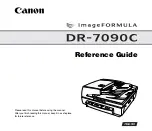
Glossary
-1
Glossary
additive primary colors
The colors of red, green and blue (RGB) - which give the perception of white when
combined equally. These are the colors of the color system used by monitors and
scanners.
bi-level data
Image data that is composed of 1 bit per pixel. A pixel is represented by a single
bit of digital data that can be expressed as only 1 (light) or 0 (dark).
bit
Short for binary digit. The smallest unit of data in computer processing. A bit can
represent one of two values: on, represented by a 1, or off, represented by a 0.
bit/pixel
The unit that indicates the number of bits allocated for a pixel. The larger the bit
value, the more detail of a pixel will be reproduced.
brightness
A scanner function to lighten or darken the output image data.
byte
A unit of information consisting of eight bits. A byte can represent a control code
or character.
carriage
A component of the scanner that contains the optical sensor and light source for
scanning.
color correction
A method of adjusting the color image data for a particular type of device so that
the reproduction results are as close as possible to the original colors.
color separation
A process of converting full-color images into a limited number of primary colors.
Additive primary colors (red, green, and blue) are used by the scanner, and the
subtractive primary colors (cyan, magenta, and yellow) plus black are used for
printing press separation.
ColorSync
Color management system for Macintosh that is designed to help you get
WYSIWYG (what you see is what you get) color output. This software displays
colors on your screen as they are on the scanned documents, or prints colors as
you see them on your screen.




































